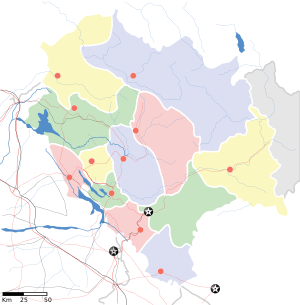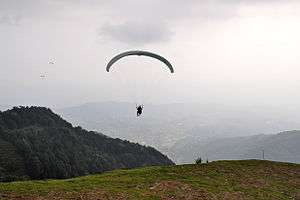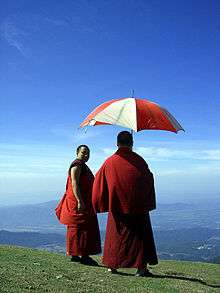Bir, Himachal Pradesh
| Bir | |
|---|---|
| village | |
 Bir  Bir Location in Himachal Pradesh, India | |
| Coordinates: 32°03′N 76°42′E / 32.05°N 76.70°ECoordinates: 32°03′N 76°42′E / 32.05°N 76.70°E | |
| Country |
|
| State | Himachal Pradesh |
| Region | Baijnath |
| District | Kangra |
| Elevation | 1,525 m (5,003 ft) |
| Languages | |
| • Official | Kangri, Hindi, English |
| Time zone | IST (UTC+5:30) |
| PIN | 176 077 |
| Telephone code | 91-1894 |
Bir is a village located in the west of Joginder Nagar Valley in the state of Himachal Pradesh in northern India.
Bir is a noted centre for ecotourism, spiritual studies and meditation. Bir is also home to a Tibetan refugee settlement with several Buddhist monasteries and a large stupa.
History
Bir was ruled by the Pal dynasty of the Chandarvanshi lineage. The last Raja or Rai was Raizada Prithi Pal, who was a descendant of the Rajas of Bhangahal, who appear to have maintained their rights until the time of Raja Prithi Pal in the early part of the eighteenth century. Raja Prithi Pal fell victim to his father-in-law, Raja Sidh Sen, who in 1728 invited him to Mandi on the pretext of seeking his assistance against the Raja of Suket. He was kindly received, but within a month of his arrival he was beguiled into the Damdama Fort, and there murdered. It is said his body was duly burnt, but his head was buried in a tank facing the Mandi Raja's palace. A pillar was erected on the spot, and a light was kept burning on it for years. Sidh Sen's object in murdering Raja Prithi Pal was to seize his territory, but in this he only partially succeeded. The forts at Jagapur, Tika Thana and the Patgana of Nir, with eighteen villages of Ilaga Chuhar (all of them until then forming part of the Bhangahal kingdom) were annexed to Mandi. Subsequently, Sidh Sen sttempted to seize Karanpur, which also belonged to Bhangahal, but he was repulsed by Raja Raghunath Pal who had succeeded his father Raja Prithi Pal. In a second invasion, he penetrated as far as Kotharli Gulu, then in Bhangahal, but Raghunath Pal was able, with the assistance of Raja Thedi Singh of Kulu, not only to check his advance, but also to beat him back with considerable loss.
The Mughal Emperors always appreciated the loyalty of the Bhanghal chiefs, and when the news of repeated aggression of the Mandhi Raja on Bhangahal reached the Emperor in Delhi, he deputed Adina Beg, Governor of Jullundur, to drive him off. But the Khan died on the road at Dinanagar in 1732. The affair ended unfortunately for Raghunath Pal, who went to meet the Governor, as Sham Sher Singh, then Raja of Mandi, took advantage of his absence to seize the much-coveted ilaqa of Karanpur.
Raghunath Pal died in 1749, and was succeeded by his son, Dalip Pal, whose reign was rendered memorable by a combined, though unsuccessful, attack made on Bhangahal by the Rajas of Mandi, Kullu, Kahlur, Nalagarh, Guler and Jaswan. The united forces of these chiefs encamped at Tika Changar, and made an attempt to capture the Raja and his brother, Mian Bhim Pal, but were eventually driven back with great loss. the Raja commemorated the victory by erecting several mounds composed of the heads of his slaughtered foes. One of these mounds exists in the pine forest in Bir, and another stands on the banks of river Pun river within the limits of Bhangahal.
Bir taaluqa was annexed in 1779 by the Raja of Kulu shortly before the death of Dalip Pal, whose son, Man pal, succeeded only to the taaluqas of Lanod and Paprola. He died on his way to Delhi, whither he was proceeding with the object of enlisting the sympathies of the Mughal Emperor in an attempt to make the recovery of his patrimony. The Rajas of Kangra and Guler took advantage of Man Pal's absence to seize villages and lands, Kangra appropriating Lanod and Paprola and Guler the remaining property. Man Pal's widow and her infant son, Uchal Pal sought refuge at Rehlu with Raja Rai Singh of Chamba, who gave her a home and allowed her a small jagir.
In 1785, when Raja Sansar Chand of Kangra married a daughter of Man Pal, he lent Uchal Pal a small force to help him in recovering his lands from Mandi Raja. This latter Chief had recourse to stratagem. He bought off Sansar Chand's principal officer and persuaded Raja Rai Singh of Chamba to carry war into Katoch dominions. When Sansar Chand found that Rai singh had advanced within a short distance of Kangra, he had to muster all his available forces, including the portion he had lent to Uchal Pal. After the battle of Nerti, in which Raja Rai Singh was defeated and killed, the Mandi and Kullu Rajas secured the possession of Bangahal by paying Sansar Chand five lakh rupees (INR 500,000).
Some time after this Uchal pal died, leaving three sons and a daughter, who lived under - Raja Sansar chand katoch protection. The girl subsequently married the Raja of Siba. Ram Pal, the eldest son of Uchal Pal died childless in 1843. The efforts of Bahadur Pal, his younger brother, to recover the family estate, were always opposed by the Raja of Mandi. Mathru, the father or Barar Pal, the head of the family in 1909, succeeded in obtaining from the British Government a pension of Rs. 500 per annum for his cousin, Mian Bahadur Pal, and this he enjoyed until his death in 1854. Barar Pal was given the title of Rai Sahib in 1895. he was a Divisional Darbari,Lambardar and Kotwal of his circle and a member of the Local and District Boards. His family held 80 acres as proprietors in Bir Bhangahal and Bir, yielding Rs. 2,200 per annum. He died in 1912. The last Head, Mian Prithi Pal, was a Zaildar and lived in Bir. He was very well spoken of by his people.
_at_the_Tibetan_Buddhist_Monastery%2CBir%2CHP%2CIndia.jpg)
The Tibetan Colony: In 1966 the third Neten Chokling (1928-1973), an incarnate lama of the Nyingma lineage of Tibetan Buddhism, brought his family and a small entourage to Bir. With the help of foreign aid Neten Chokling purchased over 200 acres of land and established a Tibetan settlement where 300 Tibetan families were given land to build houses. At this time Chokling Rinpoche also started building in Bir a new Neten monastery and disciples who had followed him into India formed its first sangha. When the third Chokling Rinpoche died in 1973, his eldest son, Orgyen Tobgyal Rinpoche (b 1951), assumed responsibility for completing his father’s vision. The fourth Neten Chokling incarnation was born in 1973 in Bhutan and brought to Bir at a young age where the family of the third Chokling took him under their wings. In 2004 full responsibility for Pema Ewam Chögar Gyurme Ling Monastery in Bir was passed to the fourth Neten Chokling.
Geography

Bir is located at in the Tehsil (administrative subdivision) of Baijnath, in the District of Kangra in the Indian state of Himachal Pradesh.
It is situated approximately 50 km (31 mi) southeast of Dharamshala at a distance of two to three hours by road. It is 14 km south of Billing, which lies on the way to the Thamsar Pass leading to Bara Bhangal.
Geologically, Bir is situated in the Joginder Nagar Valley, Dhauladhar Range of the foothills of the Indian Himalayas.
The nearest railway station is Ahju, on the narrow-gauge line running between Pathankot and Jogindernagar via Kangra.
Road access to Bir is from the Bir Road turnoff (signposted) on [[National Highway 20 (India)|N H20]( Now NH 154)], approximately midway between Baijnath and Jogindernagar.
Orientation
The historical center of Bir is in Upper Bir (Bir proper).[1]
The Bir Tibetan Colony (often simply called "Colony" by locals) is at the west end of the village of Chowgan, about a 20-minute walk (or five-minute taxi) below Upper Bir.
Sherab Ling Monastery is a 50-to-70-minute walk (or 15-minute taxi) from Chowgan, or slightly longer from Upper Bir.
The village of Ghornala is the location of the Camp Oak View, Dharmalaya Institute,[2] Ekant Homestay, Katoch Homestay, a Sikh retreat centre, and a few cottages. It is about midway between Bir and Sansal.
Katoch Homestay is a 20- to 30-minute walk (or 15-minute taxi)from Chowgan, or slightly longer from upper Bir. It is about midway between Bir and Sansal.
Population
- The population of Bir is primarily Indian agriculturalists. There is also a sizable community of Tibetan refugees in the Bir Tibetan Colony (see below) and a small community of international expatriates and long-term students, volunteers, and visitors.[3]
Prominent institutions and attractions
There are several institutions in Bir that attract students, tourists, volunteers and other visitors from around India and from abroad:
The Deer Park Institute[4] is a 'centre for the study of classical Indian wisdom traditions' established by Dzongsar Khyentse Rinpoche in March 2006 under the patronage of the Dalai Lama.[5] The Institute hosts frequent guest lectures and workshops with reputed scholars and meditation teachers.
The Dharmalaya Institute[6] is an eco-campus for service-learning and contemplative practice. Dharmalaya is an Indian charitable society (NGO) 'devoted to education, service, and compassionate living, with a practical focus on sustainable village development, contemplative service-learning, and immersive ecotourism'.[2][7] Dharmalaya hosts work retreats and meditation retreats, providing opportunities for long-term volunteers and meditation students to do karma yoga (mindful service work with an unselfish, altruistic intention) for various charitable projects to benefit the local community and the natural environment.[8] Programmes include earthen building, vernacular eco-architecture, green job skills training for local villagers, organic farming, and a tree-planting project. Visitors must contact them via the website before visiting, as they are sometimes closed to visitors for silent retreats and special programmes.
Chokling Gompa is the monastery of Neten Chokling Rinpoche, a reincarnate lama in the Nyingma tradition of Tibetan Buddhism and the director of the film Milarepa (2006). The Tibetan architecture and large stupa are the principal attractions for casual visitors. In addition to its ongoing programmes for its full-time monastic students, the monastery periodically hosts Buddhist ceremonies open to the public. There is a guest house and restaurant on the premises.
The Bir Tea Factory is a longstanding Bir cooperative, which offers tours for those interested in the process of tea production.
The Bir-Billing area is a popular destination for ecotourism and adventure travel, offering paragliding, hang-gliding, trekking and camping.

Paragliding
The paragliding World Cup 2015 is set to commence from the 21st of October in Bir.
The Bir-Billing area is a popular site for paraglider pilots, both Indians and visitors from all over the world.[9] The flying season is from September to October, with some flying also done in November. The village continues to host periodic international competitions and events.
The paragliding launch site is in the meadow at Billing (14 km north of Bir), at an elevation of 2400 metres,[9] while the landing site and most tourist accommodations are in the village of Chowgan (also spelled Chaugan), on the southern edge of Bir.
Bir Tibetan Colony

Bir Tibetan Colony is a Tibetan refugee settlement located at the west end of the village of Chowgan on the southwestern edge of the village of Bir.
Bir Tibetan Colony was established in the early 1960s following the exile of the Dalai Lama and other Tibetans from Tibet.
Bir Tibetan Colony houses several Tibetan monasteries (representing the Nyingma, Kagyu, and Sakya traditions), a Tibetan handicraft center, a Tibetan Children's Village school (Suja), a branch of the Tibetan Medical and Astrological Institute (Men-Tsee-Khang), a medical clinic, and the Deer Park Institute.
See the full Wikipedia article on Bir Tibetan Colony for further information.
In popular culture
Bir was the setting for Khyentse Norbu's first feature film, The Cup (Phörpa) (1999), which was based on events that took place in Bir during the 1998 World Cup final and was shot on location in Bir.[10]
References
- ↑ "Bir Portal - Bir Orientation: Bir, Tibetan Colony, Ghornala, BillingThe Bir Portal". Birhp. 2012-03-21. Retrieved 2012-04-05.
- 1 2 "Welcome to Dharmalaya - Dharmalaya". Dharmalaya.in. Retrieved 2012-04-05.
- ↑ "About Bir | The Bir Portal". Birhp. 2012-03-21. Retrieved 2012-08-24.
- ↑ deerpark.in
- ↑ "Welcome to Deer Park Institute". Deerpark.in. Retrieved 2012-04-05.
- ↑ dharmalaya.in
- ↑ Town, Earthville (2009-01-19). "Earthville News | Dharmalaya Sprouts: Earthville Co-founds New Charitable Organization in India". Earthville.org. Retrieved 2012-04-05.
- ↑ "Volunteer in the Himalayas & Around India - Dharmalaya". Dharmalaya.in. Retrieved 2012-04-05.
- 1 2 "1". Our Guy in India. 2015. Channel 4.
- ↑ Jakes, Susan (2003-01-27). "The God of Small Films". TIME. Retrieved 2012-04-05.
External links
| Wikimedia Commons has media related to Bir (Kangra). |
| Wikivoyage has a travel guide for Bir. |